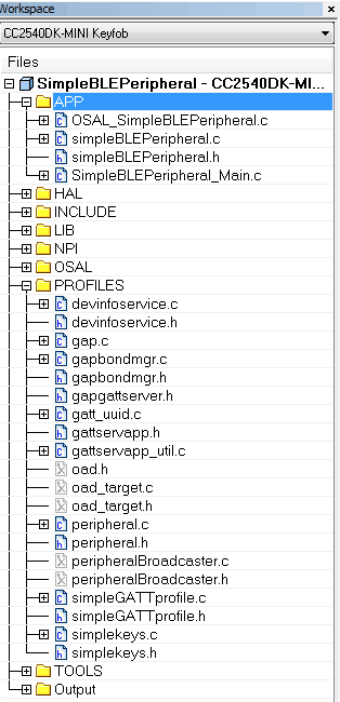SWRU271I October 2010 – January 2020 CC2540 , CC2540T , CC2541 , CC2541-Q1 , CC2640R2F
- Preface
- 1Overview
- 2The TI Bluetooth Low Energy Software Development Platform
- 3The Operating System Abstraction Layer (OSAL)
- 4The Application and Profiles
-
5The Bluetooth Low Energy Protocol Stack
- 5.1 Overview
- 5.2 Generic Access Profile (GAP)
- 5.3 GAPRole Task
- 5.4 Gap Bond Manager (GAPBondMgr)
- 5.5
Generic Attribute Profile (GATT)
- 5.5.1 GATT Characteristics and Attributes
- 5.5.2 GATT Services and Profile
- 5.5.3 GATT Client Abstraction
- 5.5.4 GATT Server Abstraction
- 5.6 L2CAP
- 5.7 HCI
- 5.8 Library Files
- 6Drivers
- 7Creating a Custom Bluetooth Low Energy Application
- 8Development and Debugging
-
9General Information
- 9.1 Overview
- 9.2 Porting From BLE-Stack 1.5.0 to 1.5.1
- 9.3 Porting From BLE-Stack 1.4.2 to 1.5.0
- 9.4
Porting From Earlier BLE-Stack Versions
- 9.4.1 Porting BLEv1.4.1 Projects to BLEv1.4.2
- 9.4.2 Porting BLEv1.4.0 Projects to BLEv1.4.1
- 9.4.3 Porting BLEv1.3.2 Projects to BLEv1.4.0
- 9.4.4 Porting BLEv1.2 Projects to BLEv1.3
- 9.4.5 Porting From CC2540 to CC2541 Project
- 9.5 Release Notes History
- 9.6 Document History
- A GAP API
- B GAPRole Peripheral Role API
- C GAPRole Central Role API
- D GATT/ATT API
- E GATTServApp API
- F GAPBondMgr API
- G HCI Extension API
- Revision History
4.2 Project Overview
On the left side of the IAR window, the Workspace section lists the files used by the project.
 Figure 4-1 Project Files
Figure 4-1 Project Files The file list is divided into the following groups:
- APP – These are the application source code and header files. More information on these files can be found later in this section.
- HAL – This group contains the HAL source code and header files. For more information on the HAL group, see Section 6.
- INCLUDE – This group includes all of the necessary header files for the Bluetooth Low Energy protocol stack API. For details, see Section A through Section G and CC2540 Bluetooth low energy API Guide.
- LIB – This group contains the protocol stack library file CC2540_BLE_peri.lib. For more information on the protocol stack libraries, see Section 5.8.
- NPI – Network processor interface, a transport layer that allows you to route HCI data to a serial interface. CC254X_BLE_HCI_TL_Full.lib must be included for this capability (see the HostTest project in the SDK). If not used, the CC254X_BLE_HCI_TL_None.lib should be used (see SimpleBLEPeripheral in the SDK) when developing a single-chip application).
- OSAL – This group contains the OSAL source code and header files. For more information on the OSAL, see OSAL API Guide and Section 3.
- PROFILES – This group contains the source code and header files for the GAP role profile, GAP security profile, and the sample GATT profile. In addition, this section contains the necessary header files for the GATT server application. For more information on these modules, see Section 5.
- TOOLS – This group contains the configuration files buildComponents.cfg and buildConfig.cfg. Section 5.8 describes these files and contains the files OnBoard.c and OnBoard.h, which handle interface functions.
- OUTPUT – This group contains files that are generated by IAR during the build process, including binaries and the map file, see Section 8.3.4.